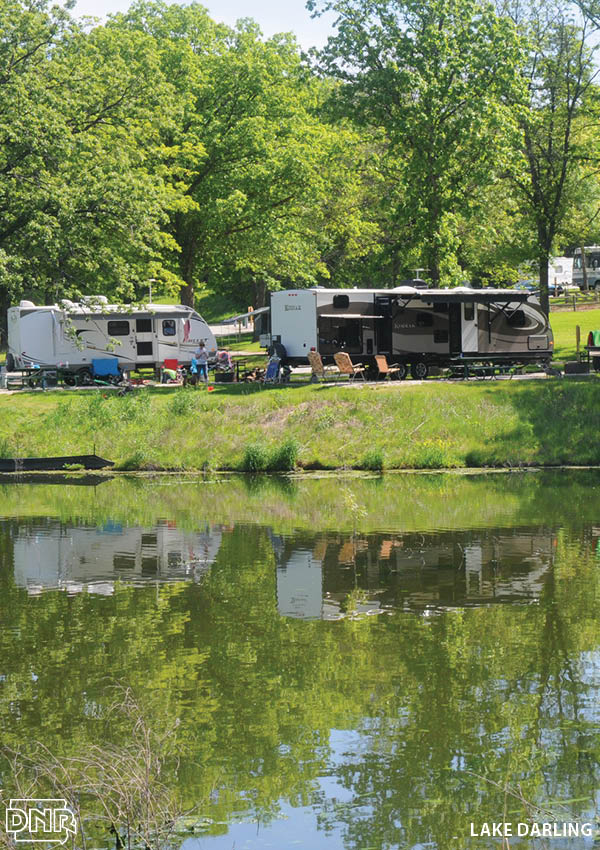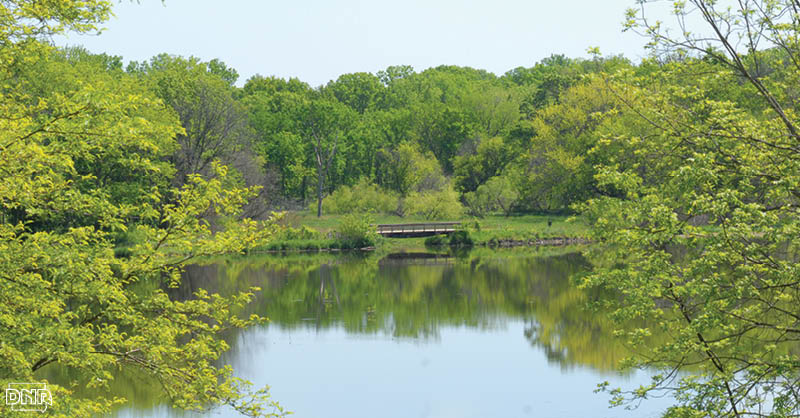
This article originally appeared in Working for Clean Water: 2015 Iowa Watershed Successes
On the same September day 64 years earlier, legendary conservationist and Iowan Jay “Ding” Darling ceremoniously “set the gate” on the then newest and largest artificial lake in Iowa, Lake Darling.
But this September 2014 gathering was more than an observation of an anniversary. It was a celebration of the rebirth of Lake Darling State Park, a triumph for the local community.
A showpiece for years, the lake’s too-large 12,500-acre watershed spanning Washington, Keokuk and Jefferson counties produced ongoing siltation, nutrient and bacteria issues in the lake. Fishing suffered. Boaters and swimmers went elsewhere.
“In the spring, the lake was the same color as hot chocolate,” says Don Kline, a former DNR fisheries biologist who tested the lake’s water clarity monthly from 1978 to his retirement.
The 305-acre lake shrank to 267 acres. Something needed to change — and the community took action. Local landowners worked together and made changes on their land. Through a watershed project, they installed 162 conservation practices, from ponds and basins to terraces and soil-holding grasses, many stretching across property lines.
The practices slow water and filter out silt, nutrients and bacteria before they can reach the lake. With additional conservation work on state land, the practices have reduced the amount of sediment reaching the lake by 60 percent.
“Without landowners, we would not have any of this done,” commented watershed coordinator Stan Simmons at the rededication ceremony. “Everything that happens up here is on land. It is owners cooperating with each other. Problems did not start at line fences. They did not stop at line fences. Many times, landowners had to work together to get problems solved. And we were very successful, in most instances.”
Recognizing the work done in the watershed to protect the lake, the DNR went to work on a four-year, $12 million renovation of the lake and park. The lake was drained, the dam replaced and the lake level restored to 305 acres. The silt trucked out from the lake would cover a football field 12 stories high — the loss of precious topsoil that the lake’s namesake worked so hard to conserve in the 1920s and 1930s.
New boat ramps, fishing jetties, piers and an accessible fishing trail welcome anglers as they cruise into the park on new roads. There’s an all-new campground, shelters, water lines, even new sand on the beach. And then there’s the lodge — comparatively the senior at seven years old, built through impressive fundraising by the Friends of Lake Darling.
“Everything is new, except the ground it is built on,” jokes DNR fisheries technician Vance Polton.
And they’re not done. The Friends of Lake Darling are at work raising funds for three new all-season cabins and for connecting park trails to nearby Brighton. They’ll see a big payoff, too — it’s estimated the work to return Darling to its showplace status will bring in an annual $8.7 million economic benefit to nearby communities, plus quality of life benefits, too.
“Lake Darling is back,” said DNR fisheries biologist Chad Dolan to the supporters gathered. “It surely would not have happened without you.”
